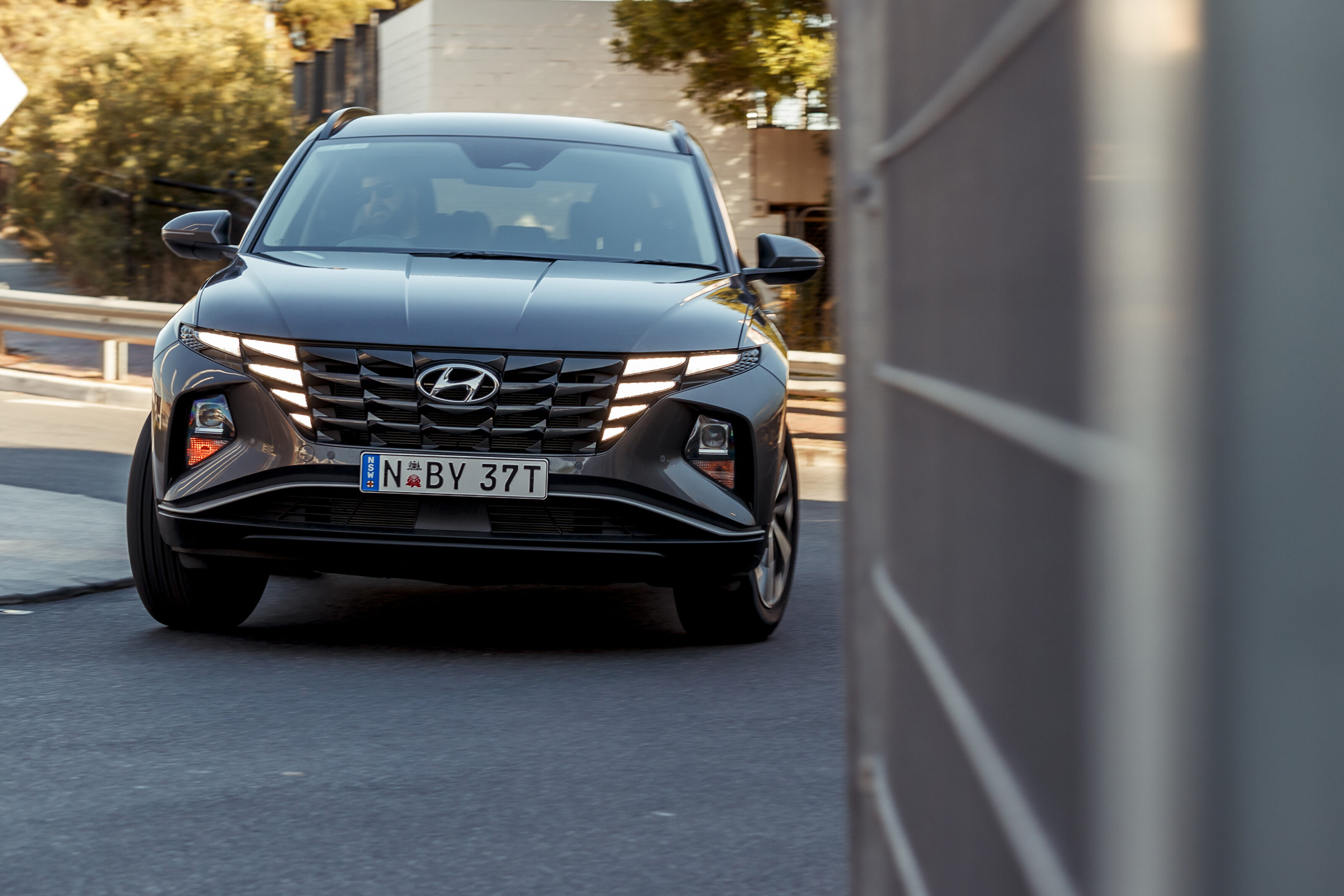Things we like
- Details-oriented design themes
- Competitive standard-fit safety features
- Spacious cabin
Not so much
- 2.0 litre non-turbo petrol engine doesn't inspire confidence
- Lane-keep system overly aggressive
- Welcome
- Month 1: Family hauling
- Month 2: The quite decent indoors
- Month 3: Geek Chic
- Month 4: Change in heart
November 21, 2023: New-look 2024 Tucson revealed
Hyundai’s top-selling vehicle updated with Santa Cruz-like front end, plus a new-look dashboard inspired by the Kona and Santa Fe
Story continues: Living with the 2022 Hyundai Tucson
Price as tested: $39,000 (before on-road costs) Fuel since collected: 1379km @ 10.5L/100km
Welcome
Edgy.
Like the huge new Hyundai Palisade, the new-generation 2021 Hyundai Tucson is edgy – but more literally so. Where the Palisade takes a few leaps of faith in its front and rear styling, the Tucson is wrapped all-round in sharp edges and bold angles.
From its heavily creased character lines to its futuristic lighting signature at the front and harpoon-like brake lamps, the new midsize Tucson represents a truly generational step beyond the safe styling of its predecessor.
It’s the sort of brave move a brand can only make when it’s confident the market has accepted it as an established top-10 brand, and an aspirational one.
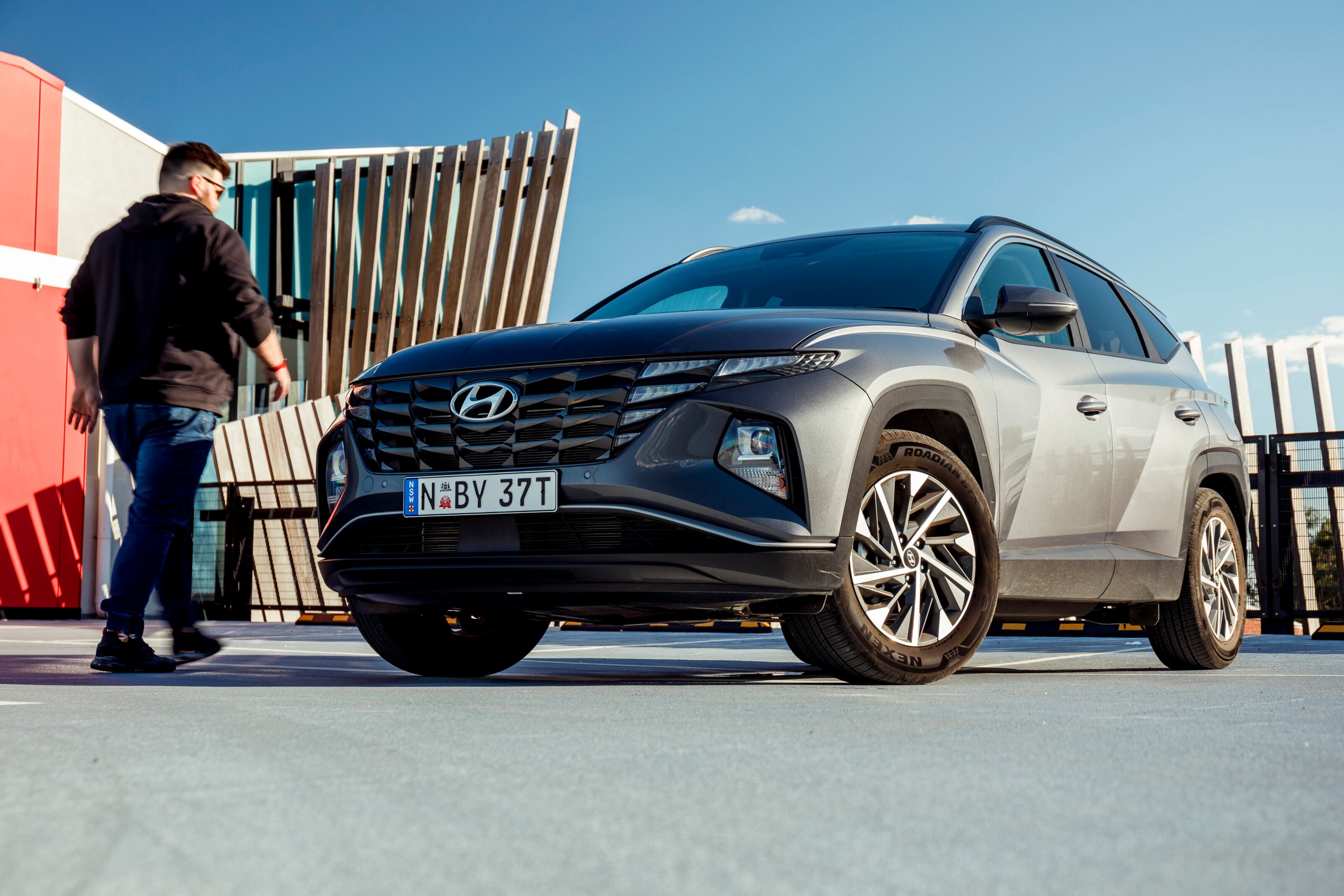
What are the highlights?
I’m driving the new Tucson in mid-level $39,000 (before on-road costs) Elite grade, which gets me upgraded from 17- to 18-inch wheels, cloth to “leather-appointed” seats, and a larger 10.25-inch touchscreen display (up from eight inches).
Other highlights above the fairly well-equipped $34,000 base model include dual-zone climate control, heated front seats, rain-sensing wipers, and a ‘smart key’ with push-button start.
I’m not rapt to see that the Elite goes without a full digital instrument screen, though, with that feature and a number of others reserved for the top-shelf $46,000 Highlander grade. In its place are classic analog dials and a small 4.2-inch info display. At least it’s full-colour…
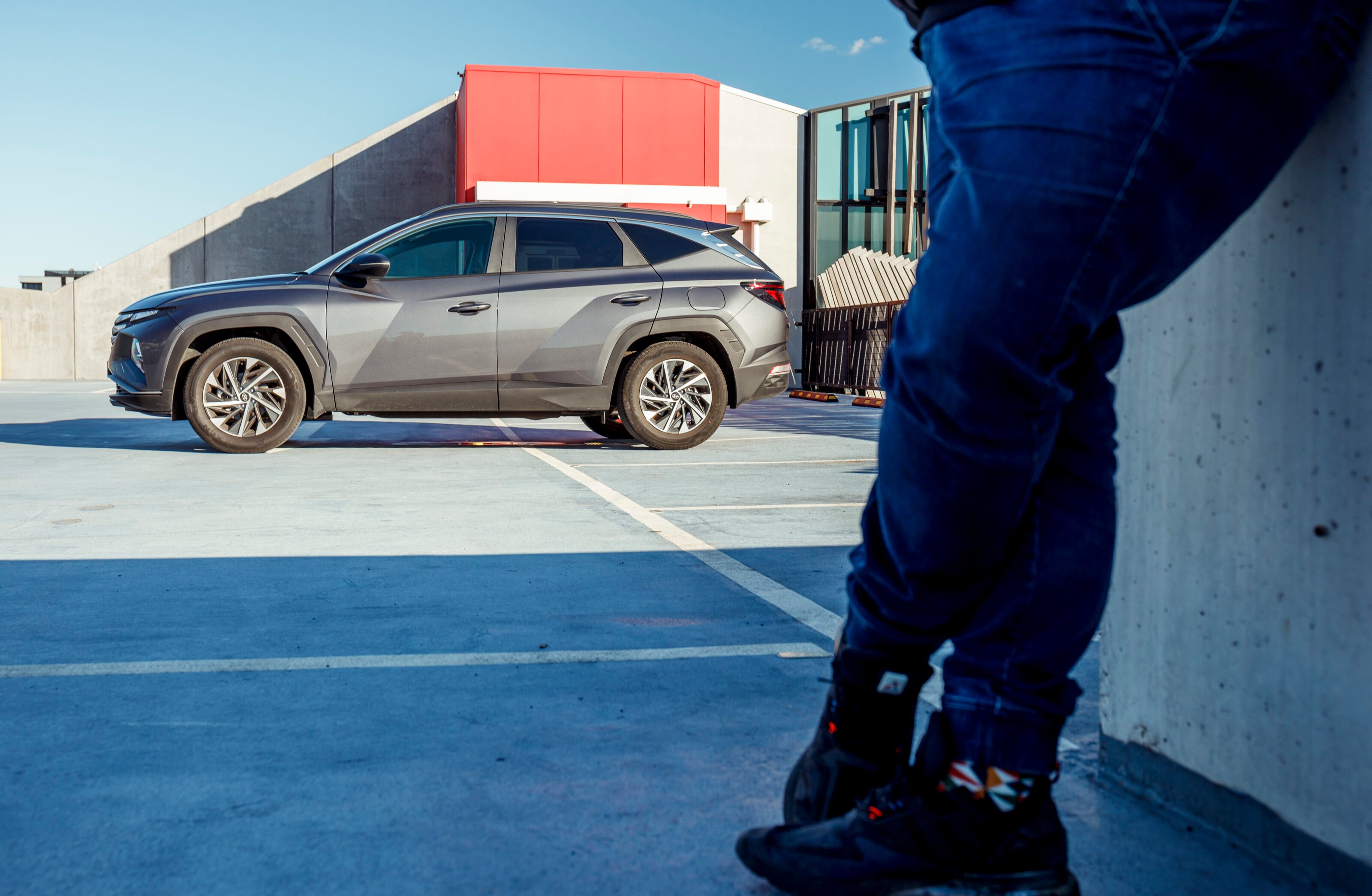
Safety
To its credit, Hyundai equips every Tucson with a level of safety kit you’d normally expect to see only in higher grades – such as blind-spot monitoring and lane-keep assist, autonomous emergency braking, rear cross-traffic collision avoidance, active cruise control (‘Intelligent Speed Limit Assist’), rear occupant alert and leading vehicle departure alert. That last one is a boon for motorists sitting frustrated behind distracted drivers.
Getting to know you
First impressions of the new Tucson are really quite good, and in some respects even a little premium. There aren’t many aspects of the car’s styling that have escaped its deeply details-oriented designer’s attention, inside and out.
In the cabin, where the fine details can matter the most, there are neat tricks like a knurled effect to the rotator switches on the indicator and wiper stalks – a treatment usually found in Volvos and BMWs – and a unique horizontal four-spoke design to the steering wheel that shows Hyundai isn’t doing anything by the numbers. Indeed, this is one of three or four wheel designs Hyundai seems to be experimenting with, while most brands will stick with one to keep the costs down.
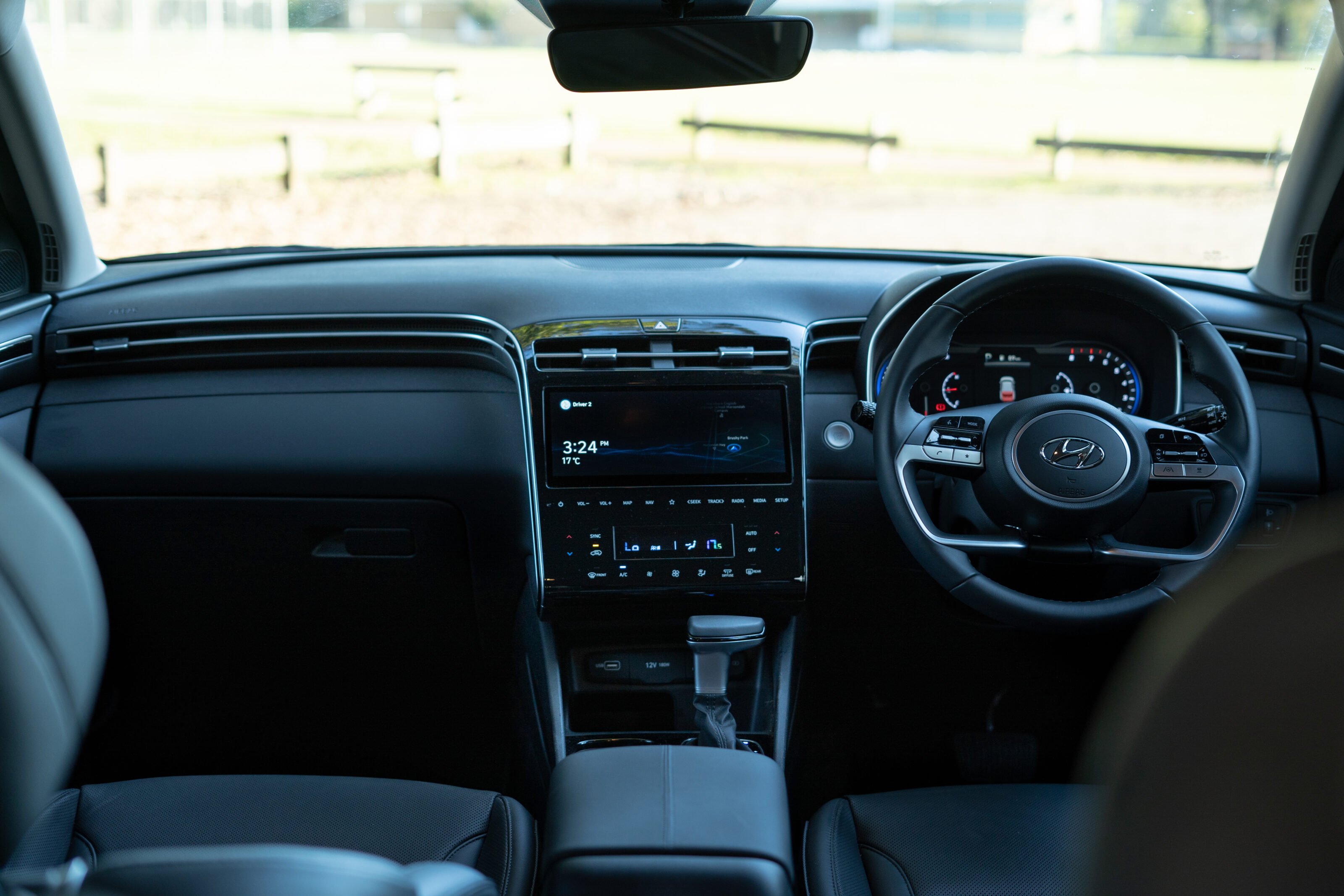
Elsewhere in the cabin, there’s a lovely tight-weave fabric band running across the dash and through the top of the door cards, beneath an almost art deco-inspired silver and gloss black that integrates the outboard air-conditioning vents.
That gloss black trim continues down the centre stack and through the console. It’s a polarising feature in the way it looks lovely when new but spends most of its life covered in dust and fingerprint grease, and the curse is worsened by the use of capacitive touch controls embedded in the gloss black panel – leaving you no choice but to spoil the pristine shine of that glossy surface.
Overall fit and finish in the cabin is comfortably on par with the latest generations of its key rivals, like the Toyota RAV4, Mazda CX-5, Subaru Forester and Skoda Karoq.
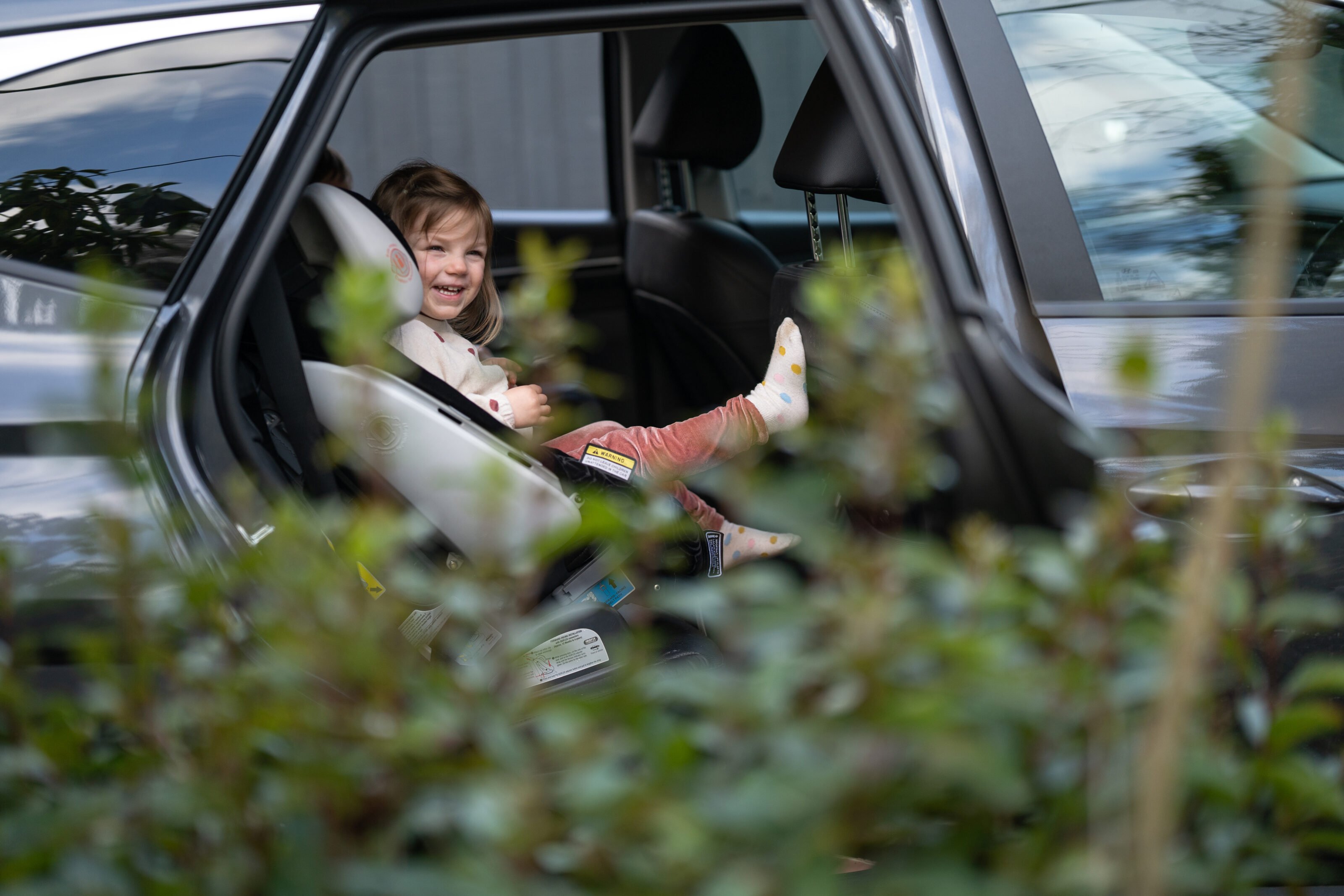
Is it roomy?
Space and comfort is also good for the segment. We’ll explore the five-seat cabin’s qualities further in a later instalment, but it’s important to note that Australian buyers get the longer 2755mm version of the Tucson’s wheelbase, rather than the 2680mm footprint that serves as the standard option in Europe – and that means more space.
That longer wheelbase is matched to an overall longer body, measuring 4630mm – a sizeable 130mm beyond the short-wheelbase version.
By comparison, the RAV4 rides on a 2690mm wheelbase and measures 4600mm long overall. These are small differences on a ruler, but it can often reveal a marked difference in practice. We’ll dive into that further in a future update.
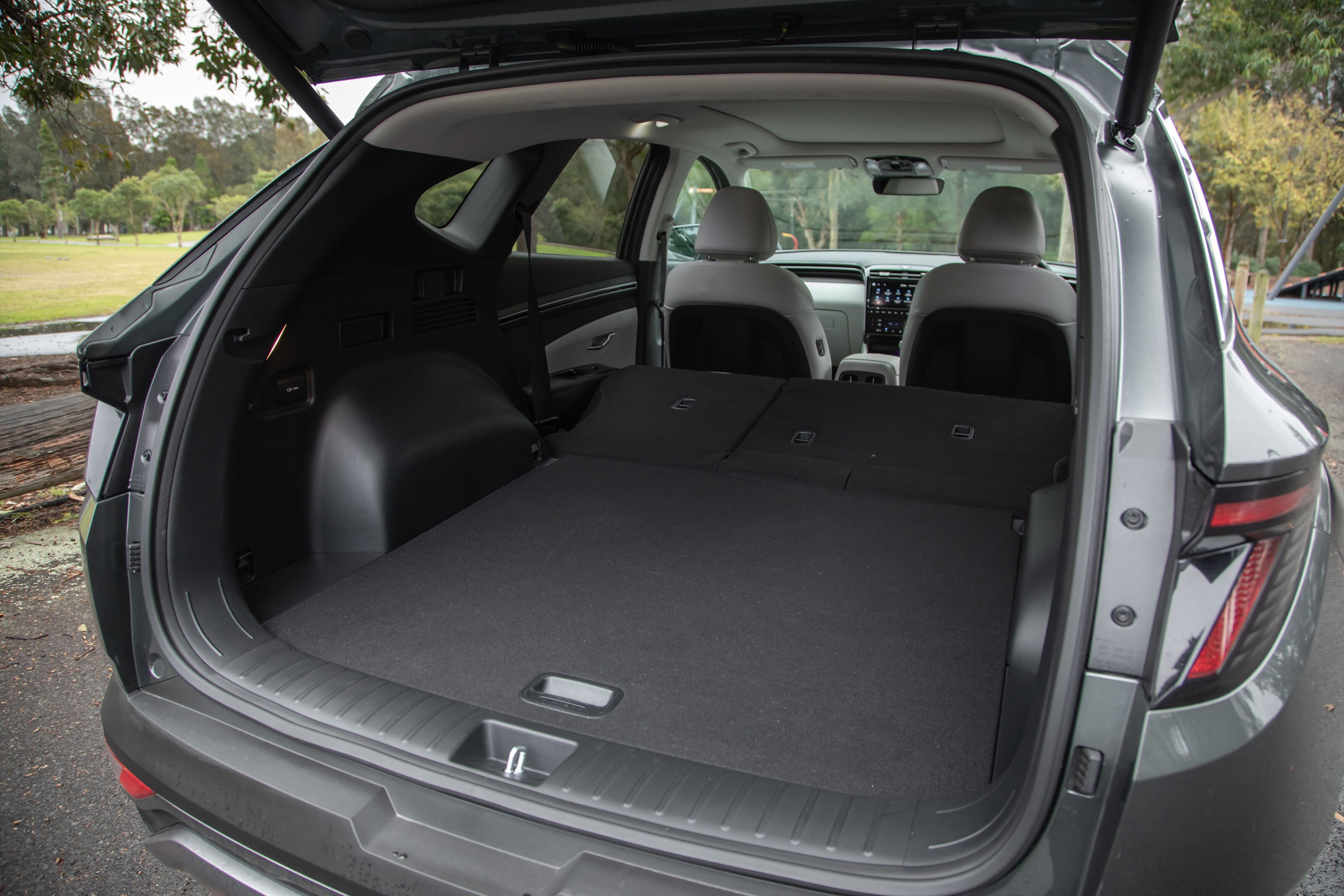
Your biggest question may be how it drives, and we’ll cover that next time. What you need to know for now is that all variants of the new Tucson launched initially with a 2.0-litre naturally-aspirated four-cylinder petrol engine, matched to a six-speed automatic transmission and front-wheel drive.
That’s not an inspiring combination, and buyers with a healthier budget would do well to consider either the gutsier 1.6 turbo petrol model with its seven-speed dual-clutch automatic and all-wheel drive, or the 2.0-litre turbo diesel eight-speed auto with AWD. You’ll pay more, though, with the Elite grade of those two configurations priced from $43,000 and $45,000 respectively.
The little ol’ 2.0-litre unit isn’t quite a lost cause, though – but you’ll have to come back in a little while for that story.
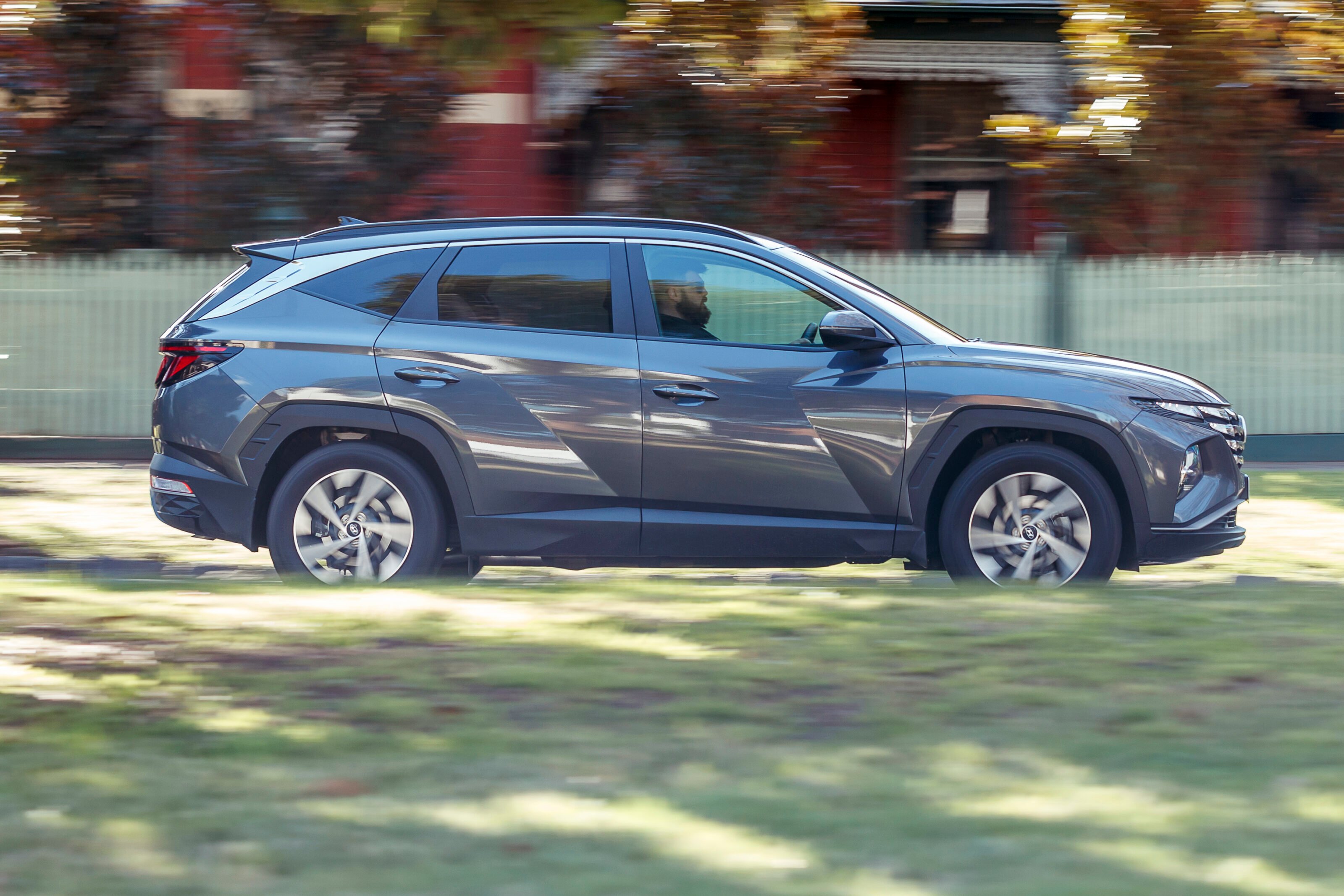
Design walkaround
Update One: Family hauling
This is the least powerful and perhaps least compelling drive configuration in the Tucson line-up – but am I just being too much of a revhead?
Fuel since collected: 2506km @ 10.4L/100km
In its 2.0-litre petrol form, with no turbo to give it a good shove, this Tucson is certainly the least confidence-inspiring option when it comes to getting up a hill in a hurry – particularly with a full family and load on board.
For that reason, it’s also the cheapest option in the range, coming in at $4000 and $6000 more affordable, respectively, than the 1.6-litre turbo petrol and 2.0-litre turbo diesel versions – both of which add more gears and all-wheel drive where our long-termer has six forward gears and front-wheel drive only.
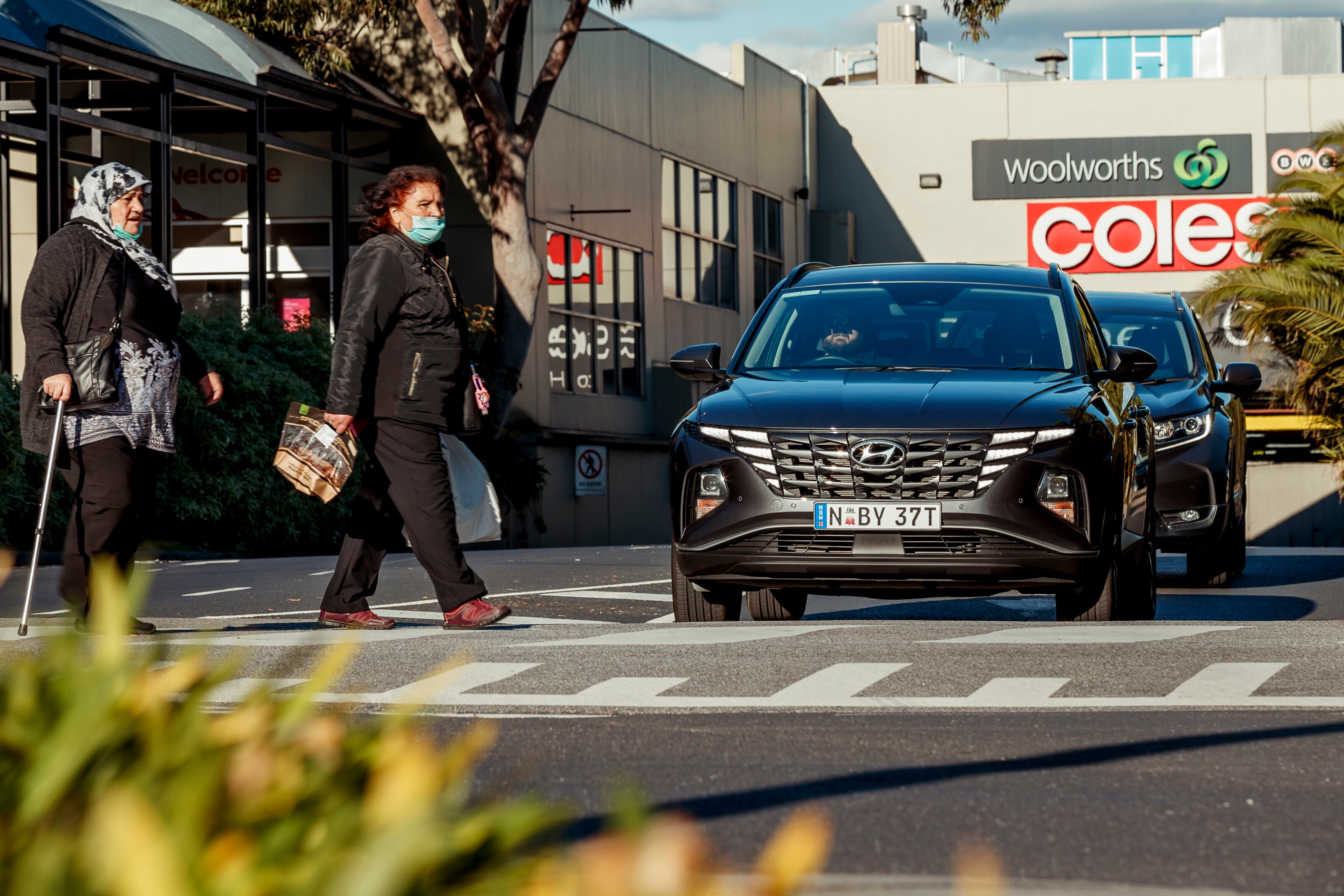
Despite these shortcomings, my experience has actually been positive – and as always, I can thank my partner. Because, where I’m always the one to bemoan a lack of grunt (“for overtaking, for towing!”), my partner is the sensible one.
She’s the one with the wisdom to know that in most day-to-day driving – even with both of us and our two little ones on board with their scooters and a picnic basket – there’s enough power here.
And she’s right – for the most part. There’s a mighty big hill at the end of our street, and whipping out in front of not-too-distant traffic will get the front rubber chirping with the non-turbo four-pot revving panting “I think I can, I think I can” – but it gets there just fine, and without any grumpy high-beam flashes in the rear-view mirror.
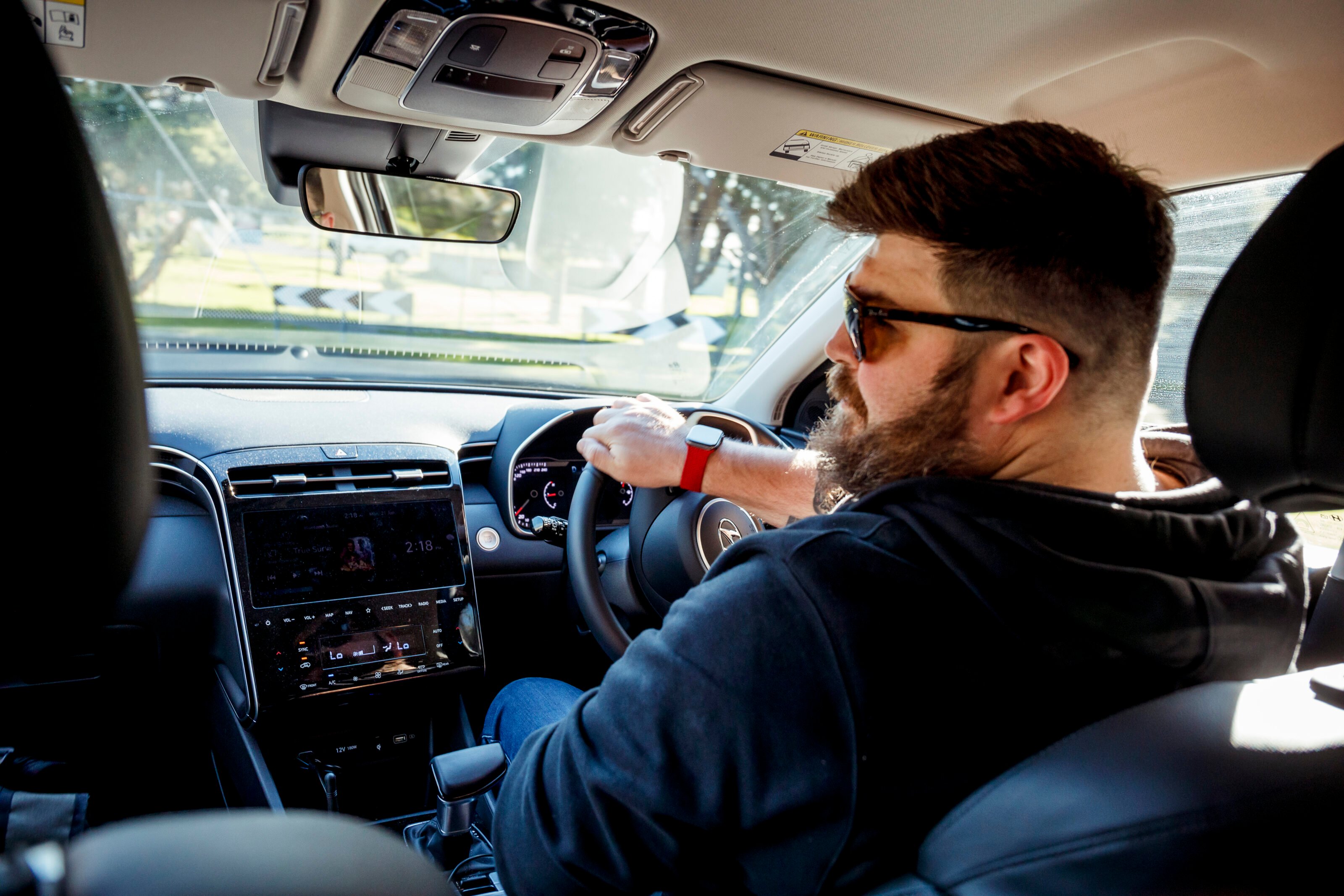
(If you do anticipate family road trips, with the kids on board, a full boot and maybe a trailer – then, yes, that’s the time to seriously consider the 1.6 turbo petrol or the 2.0 turbo diesel.)
And really, this Tucson’s six-speed auto at least saves me from the raucous buzzing I’ve often had to endure with the CVT auto preferred by many brands – although it’d be nice to have some paddle shifters to gear up rather than having to ease off the pedal until the computer agrees to shift up.
That six-speed auto is otherwise a fairly smooth unit, shifting smoothly in relaxed driving and waking up quickly enough when more is demanded.
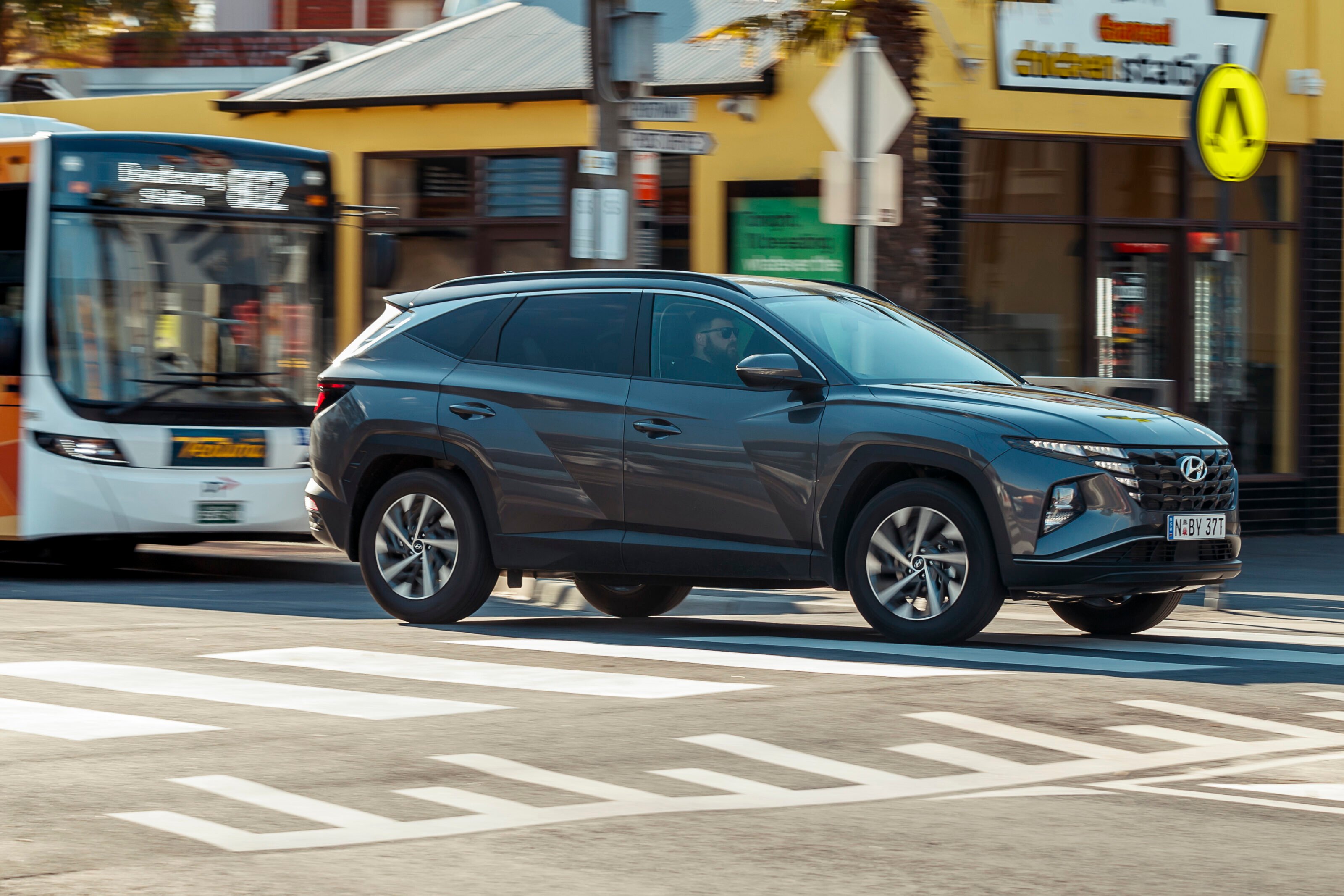
Ride comfort on the Tucson Elite’s 18-inch wheels is firm but reasonable, with good compliance and confident steering – despite this new Tucson missing out on the local tuning Hyundai Australia has undertaken in the past (it’s good enough without it, they say). Cabin ambience is also impressive, with respectable levels of wind and road noise entering the cabin.
Fuel use over the past couple of months has landed about where I’d expect. Officially, this variant lists a combined figure of 8.1L/100km; or 6.5L/100km on the highway and 11L/100km in local urban driving. With less travel to the office these days, most of our driving has been urban with only a little highway time, and we’re averaging 10.4L/100km – so it’s right in the claimed range, and in the 108km travelled since the last refill, we’ve averaged 9.2L/100km.
So, while easily dismissed as the one to skip, this simple configuration – 2.0 litres, no turbo, front-wheel drive and only six gears – could prove itself for a lot of budget-focused families as “The Little Engine That Could”.
Update Two: The quite decent indoors
With a spacious cabin and a near–premium feel to many of the surfaces and switches, the new Tucson represents a big step forwards for the line – but it could stand to try on a few tricks
Fuel since collected: 3321km @ 10.2L/100km
I’ve gone a month without cleaning the interior of my long-term Tucson Elite and, with two young kids, it looks more like a year – but this is somehow still a lovely place to sit.
I’ve now travelled a couple-of-thousand kilometres in this 2.0-litre petrol, non-turbo, front-wheel-drive, six-speed automatic family hauler, and it’s been hard to find fault with the quality and comfort of its cabin.
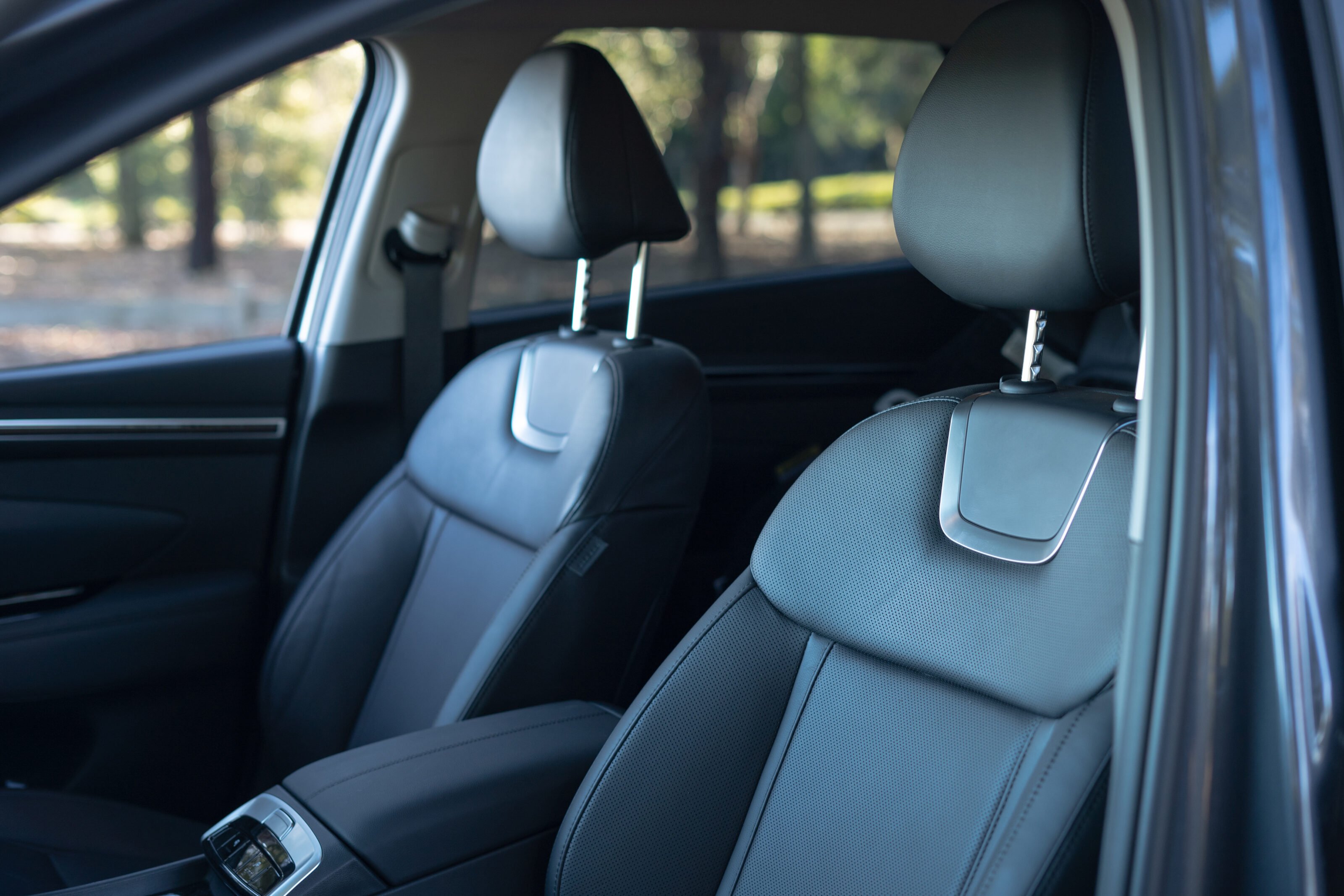
Starting from the driver’s seat, the Elite grade’s leather-trimmed pews proved themselves over a 300-kilometre round trip, with excellent support in the seatback, base and thighs. Bolstering is likewise good, although obviously not cosseting to sports-car levels. The heated seats are also welcome in this winter long-term test.
Moving into the rear invites clichéd thoughts of Doctor Who’s Tardis, thanks to Australia’s version of the Tucson being the 2755mm long-wheelbase design.
At five-feet-nine-inches tall, I can sit comfortably behind my own driving position with plenty of knee room and a spacious area beneath the driver’s seat to wiggle my toes. Headroom is likewise good (there’s no space-eating sunroof in my tester), and the rear seats recline for extra road-trip comfort.
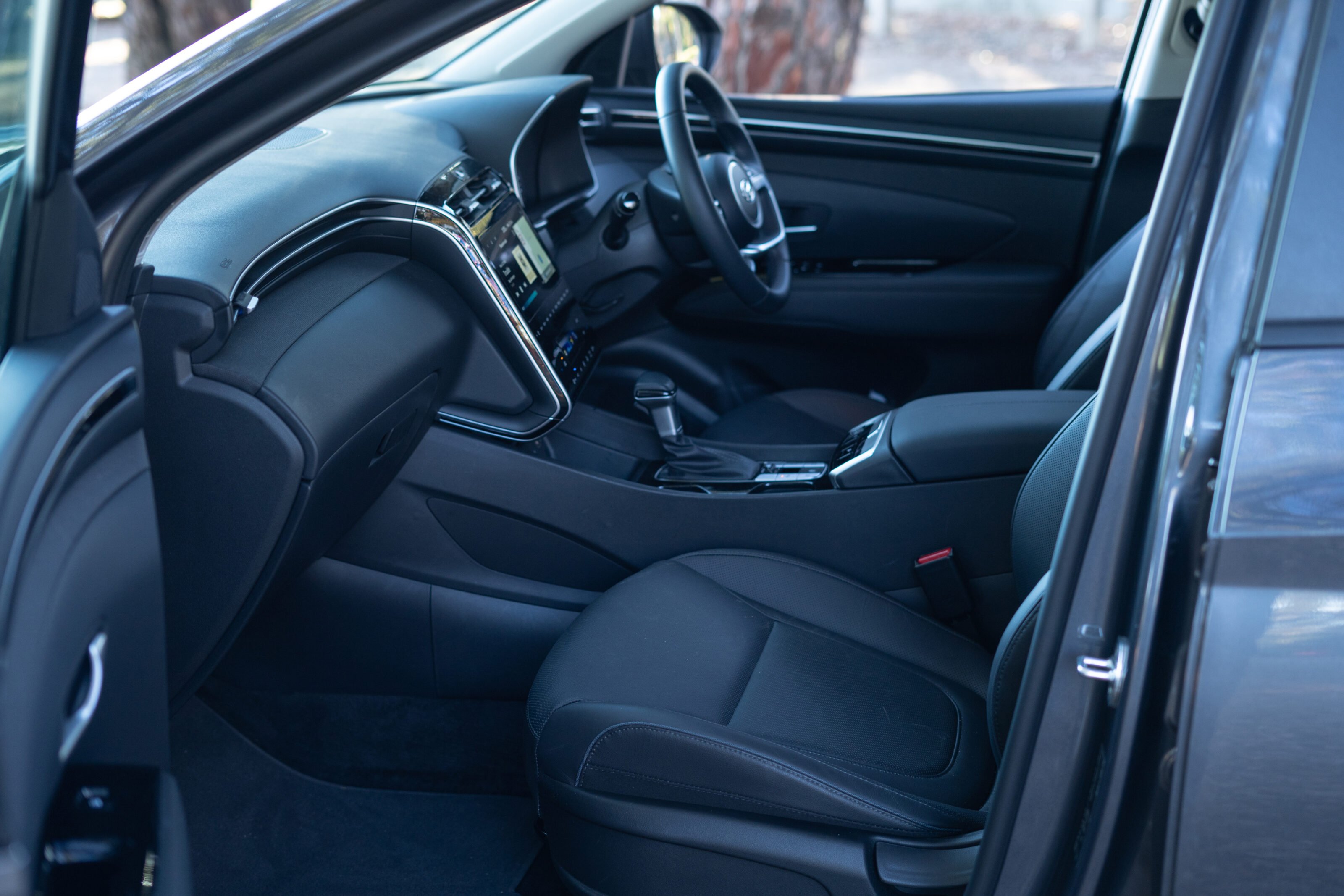
Space across the second row is good for a mid-size SUV, with room for three average-sized adults to sit comfortably – if a little cosily. The Tucson’s low-rise transmission tunnel also means the middle passenger can keep their feet close to centre, rather than stealing too much footroom from the outboard passengers.
There’s heating/cooling vents in the rear of the centre console, but with ‘only’ dual-zone air-conditioning on offer, you’ll be at the front row’s mercy for temperature and fan control.
For young families, there’s two pairs of ISOFIX points in the outboard positions, and three top-tether points. This means you could potentially fit three child seats across the second row, although it could be a squeeze – and the middle seat would miss out on the extra security of ISOFIX, leaving you only with the tether and seatbelt pass-through.
Access is good, too, with wide-opening rear doors perfect for getting the kids in and out – but those doors are long, so watch for damage to neighbouring cars.
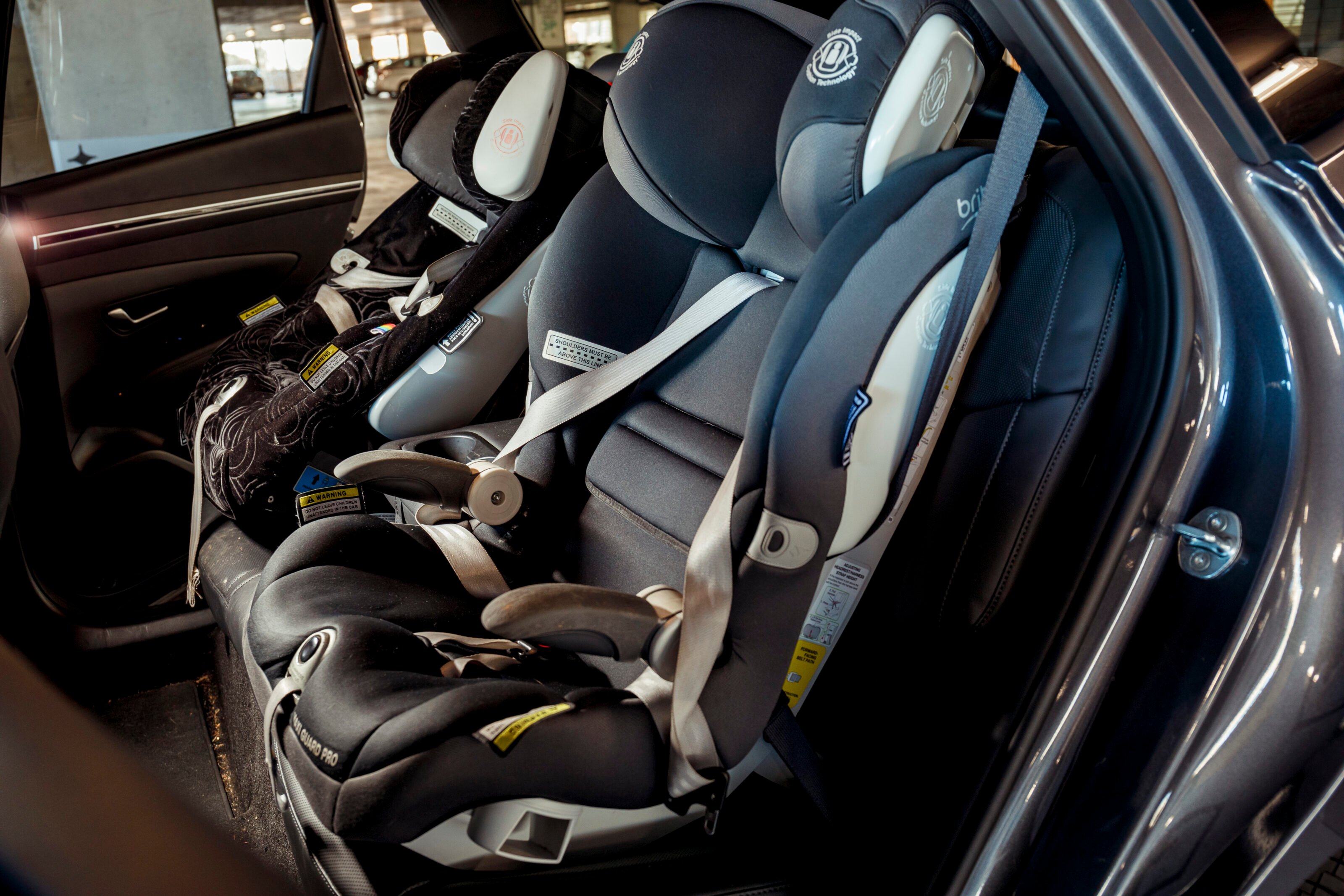
In terms of storage, the Tucson offers a cavernous 539 litres in the rear (1860 with the second row folded), but otherwise it doesn’t really move the game forward.
There’s a useable cubby under the centre stack (with wireless charging), a deep centre console and a reasonable glovebox, but the door pockets are nothing special – you wouldn’t fit a classic Melways on its side in the front pockets.
The front cup-holders are large, but the rear centre cup-holders won’t take the kids’ 400ml Camelbak Eddy Kids drink bottle (my experience at school dropoff suggests this bottle is a bit of a universal standard).
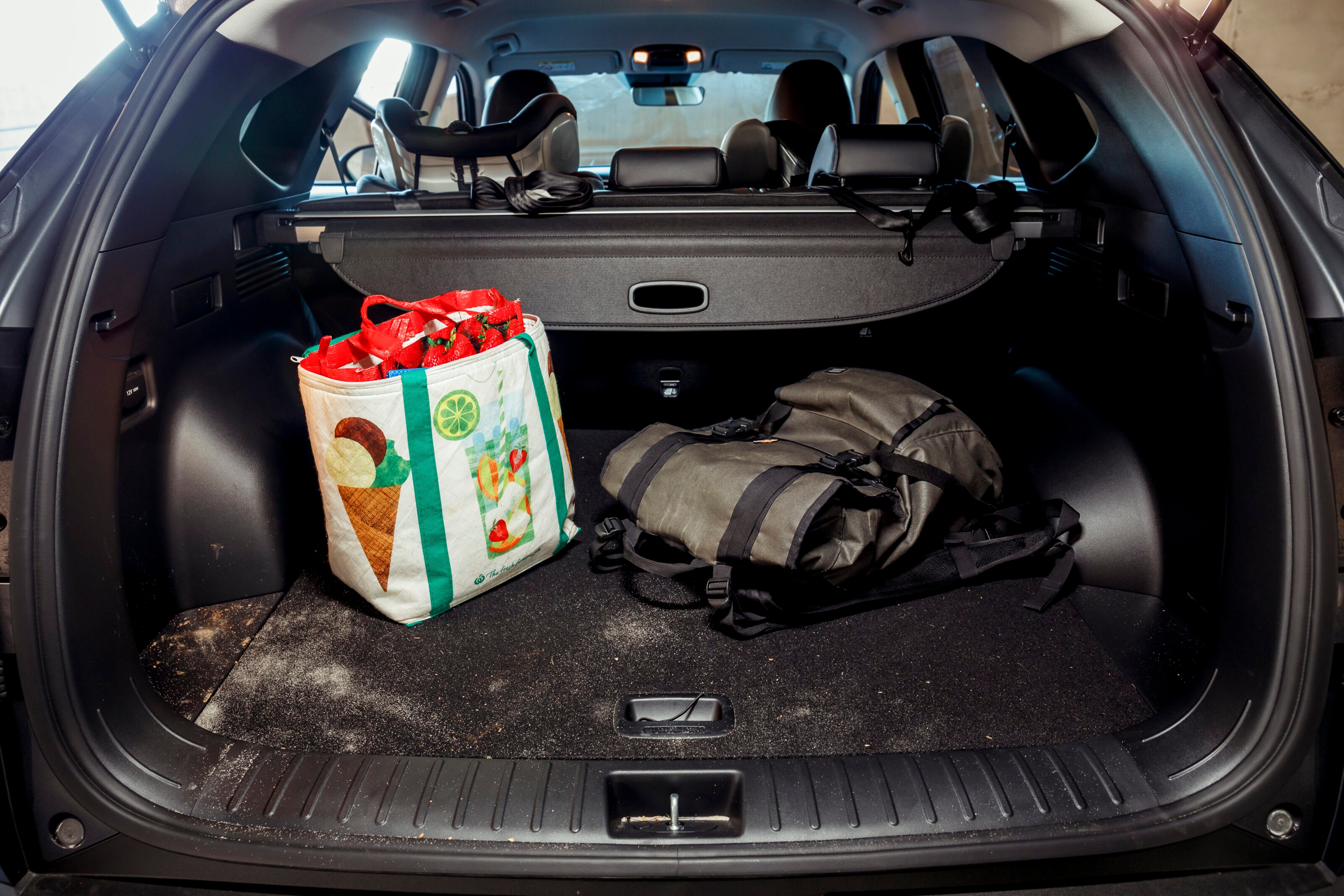
Back to the boot, there’s a wide and tall opening with a flat loading surface, allowing you to slide heavy items straight out.
There’s nothing on offer in terms of under-floor storage, thanks to the full-size spare wheel, but you could store a few small items in the wheel’s cavity. And while you get a net that can be hooked at all four corners, looping your shopping bags around the tiny built-in bag hooks can be a challenge. Some larger flip-out hooks would be welcome.
There’s nothing here that can’t be easily overcome, though, and the new Tucson’s cabin is an easy place to recommend you spend some time.
Next month, before we wrap things up, I’ll explore the new Tucson’s infotainment system – and talk a little about Hyundai’s overbearing lane-keep assist system…
Update Three: Geek Chic
A deeper dig into the Koreans’ tech suite
Fuel since collected: 4359km @ 10.3L/100km
Technology in the Hyundai range is a bit of a Jekyll & Hyde tale. The brand’s infotainment suite – that is, what you see on the cabin’s screens – is a masterclass in simplicity and user-friendliness. Where some systems will hide settings and bury features four menus deep, Hyundai’s infotainment is clean, modern, and Apple-like in its ease of use.
Hyundai’s active driver assistance systems, on the other hand, can at times manifest as irritating and – when it comes to lane-keep ‘assistance’ and collision sensing – a bit frightening.
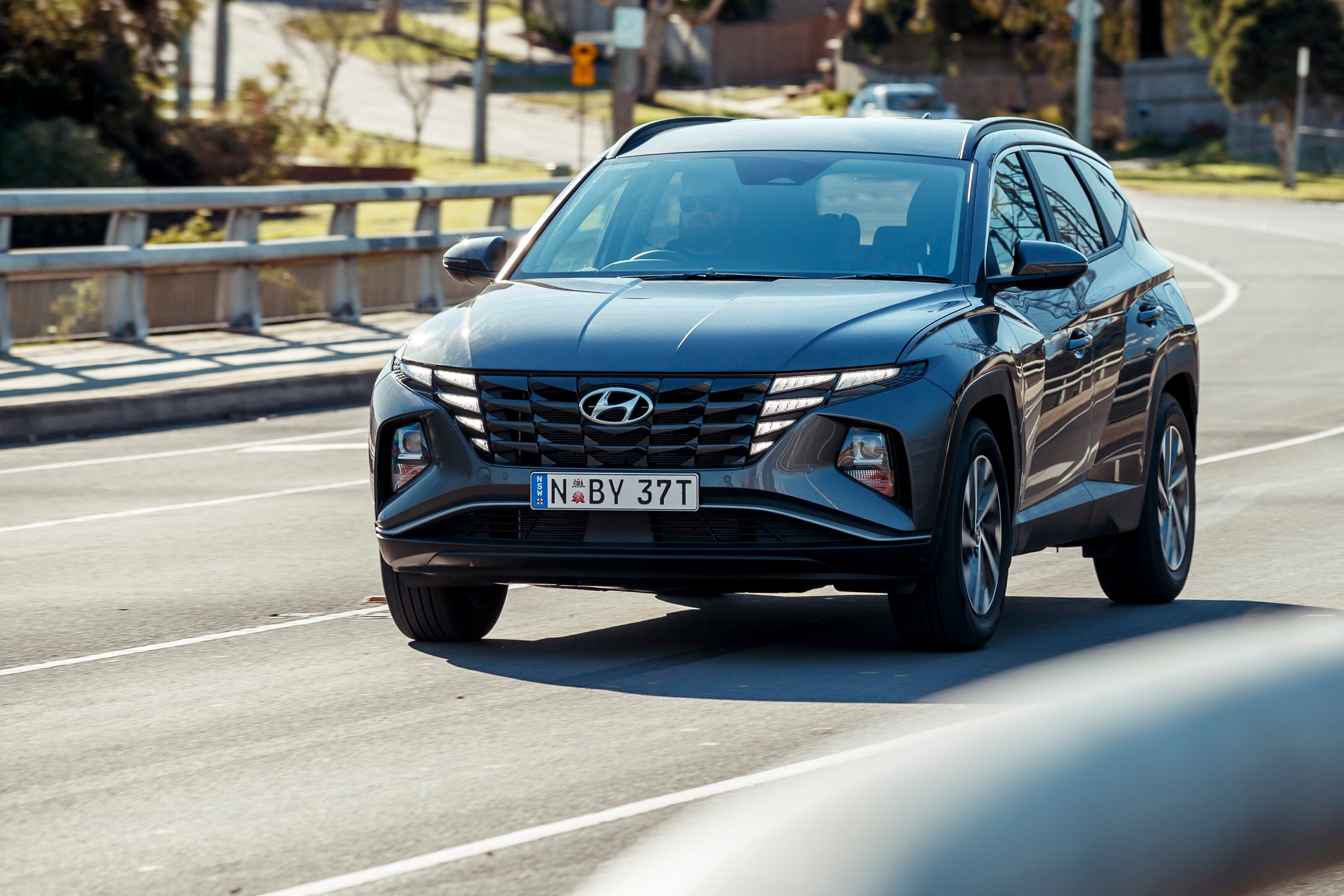
I’ll look at driver aids in my wrap-up next month, but for now: infotainment. My mid-spec Tucson Elite is equipped with a big 10.25-inch main display (shared with the top-shelf Highlander), which is an upgrade on the 8.0-inch display featured in the base model.
Apart from a greater overall piece of real estate for information, the bigger screen means you get the stylish new look of Hyundai’s latest interface, rather than the older, flat, no-nonsense look that still lives on the smaller display.
In the Elite, Hyundai’s infotainment can offer a split-screen appearance, allowing the right third to be swiped open and pinned with a compact map view or media controls, or less useful compass and clock views. You can flick through those four, or disable any that you don’t want to see. The remaining space on the left carries on as your main view to browse other functions and features.
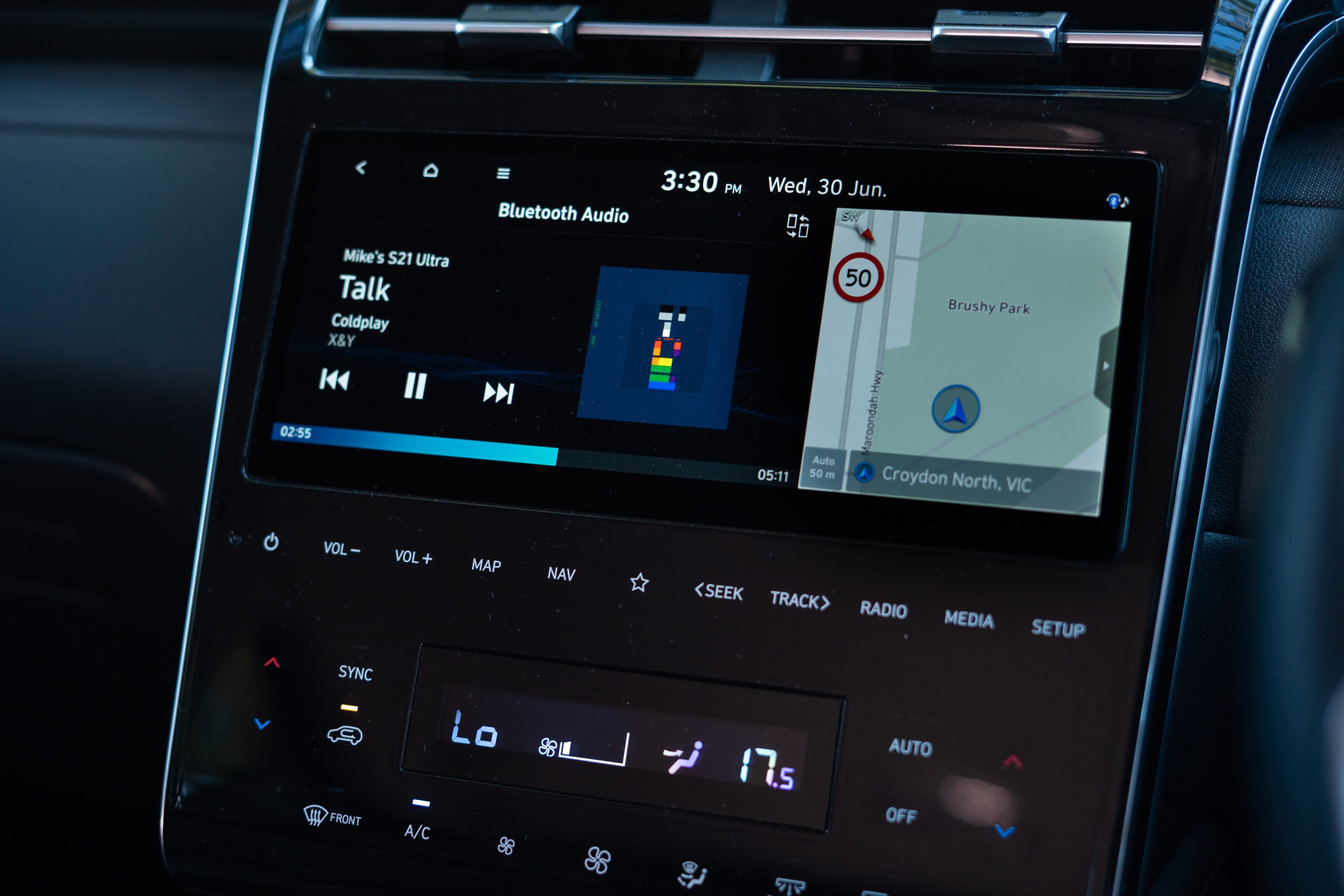
The integrated sat-nav system is lag-free when tapping out your destination, which is handy as it offers no voice input – unless you’re running (wired) Apple Carplay or Android Auto – while the map view itself is fast to swipe around on. As with other brands, the system will also offer to find and navigate to a fuel station if you become perilously low on fuel.
For owners who service their cars within the Hyundai dealer network, roads and points of interest are kept current at service times – and that’s good for 10 years of free updates.
In Elite form, the Tucson gets a rear-view camera but no front view (limited in all Hyundais to the Highlander grade). It’s a good clear display, if not particularly high-resolution, and it offers both direct-rear and above views – the latter being above the rear of the car only, as it lacks the side and front cameras to offer a 360-degree view.
Behind the steering wheel is a conventional instrument cluster with a small 4.2-inch full-colour multi-function flanked by an analogue speedo, tacho, temperature gauge and fuel gauge.

The display shows all the usual details like speed (that’s my usual setting; there’s no head-up display and the big speed number on this screen is easier at-a-glance than the analogue dial), fuel consumption, distance to empty, attention level (measured by sensing torque input on the steering wheel), navigation, and tyre pressure monitoring.
In all, it’s a largely traditional offering. Everything you’ll need is here, with none of the ‘value add’ remote connectivity or web-surfing fluff you might be unlikely to use – although, whether that’s a user-focused decision or a cost-saving one is probably a glass half-empty or half-full question.
Update Four: Change in heart
Overactive assist, and the diesel switch
Price as tested (diesel): $45,000 (before on-road costs) Fuel since collected: 1207km @ 8.6 L/100km
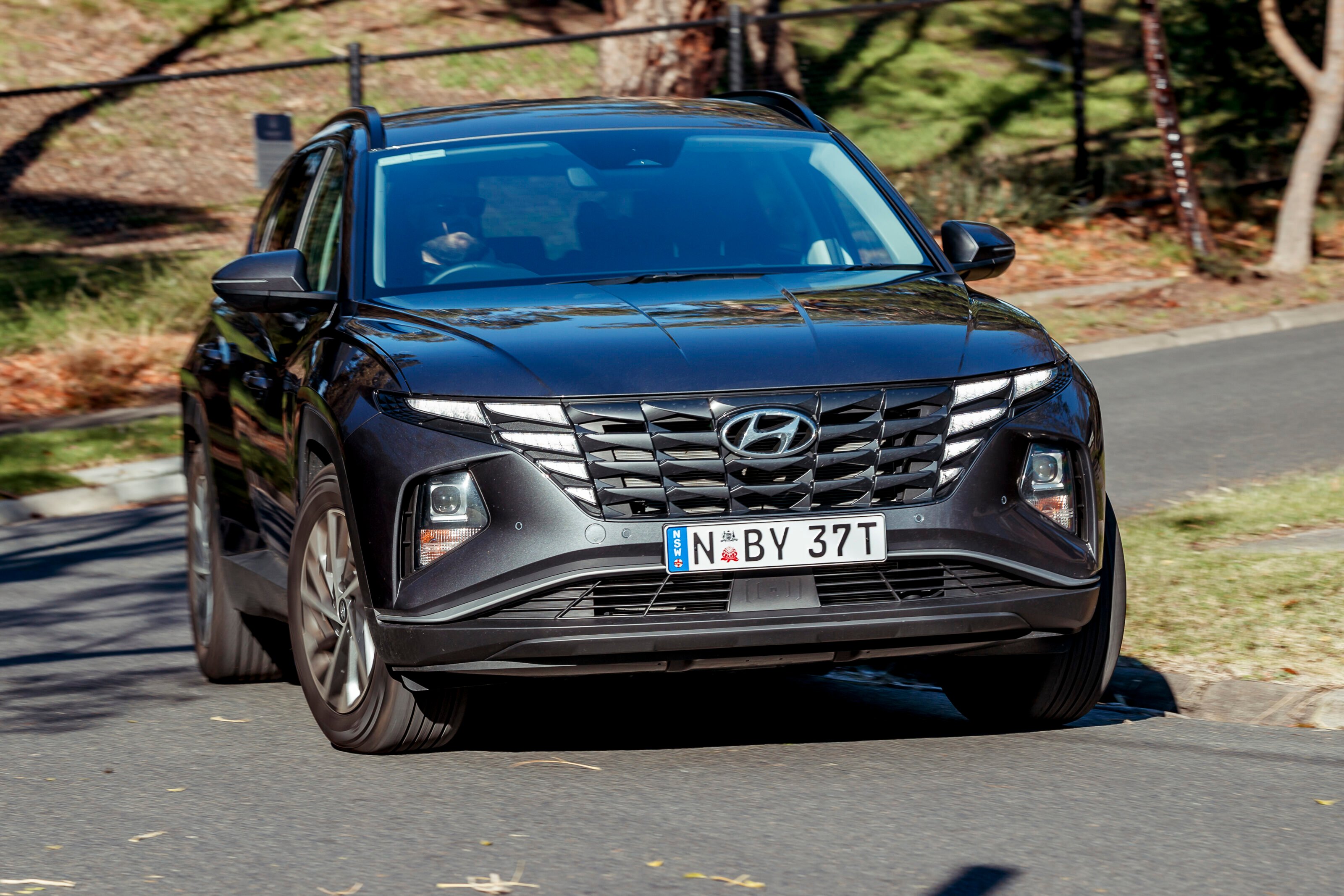
Here we are at the end, and it’s been a good thing, this new-generation family SUV. With its spacious cabin, near-premium fit and finish, modern and user-friendly infotainment, and head-turning looks, the Tucson is an easy one to recommend.
Still, it’s not all roses and sunshine. In its cheapest 2.0-litre petrol forms, the Tucson’s pulling power presents as just barely adequate rather than genuinely fit for purpose. Never outright disappointing, but neither is it ever satisfying. Suited to business fleets more than family hauling.
Drive configuration aside, Hyundai’s latest offerings have one standout bug – lane-keep assistance. Too often, my Tucson tester has worked so obsessively to keep me from the gutter on my right that it’s properly thrown me towards the clear and bright lane markings on my left. More than once, I’ve had to muscle the wheel to keep the car in my own lane.
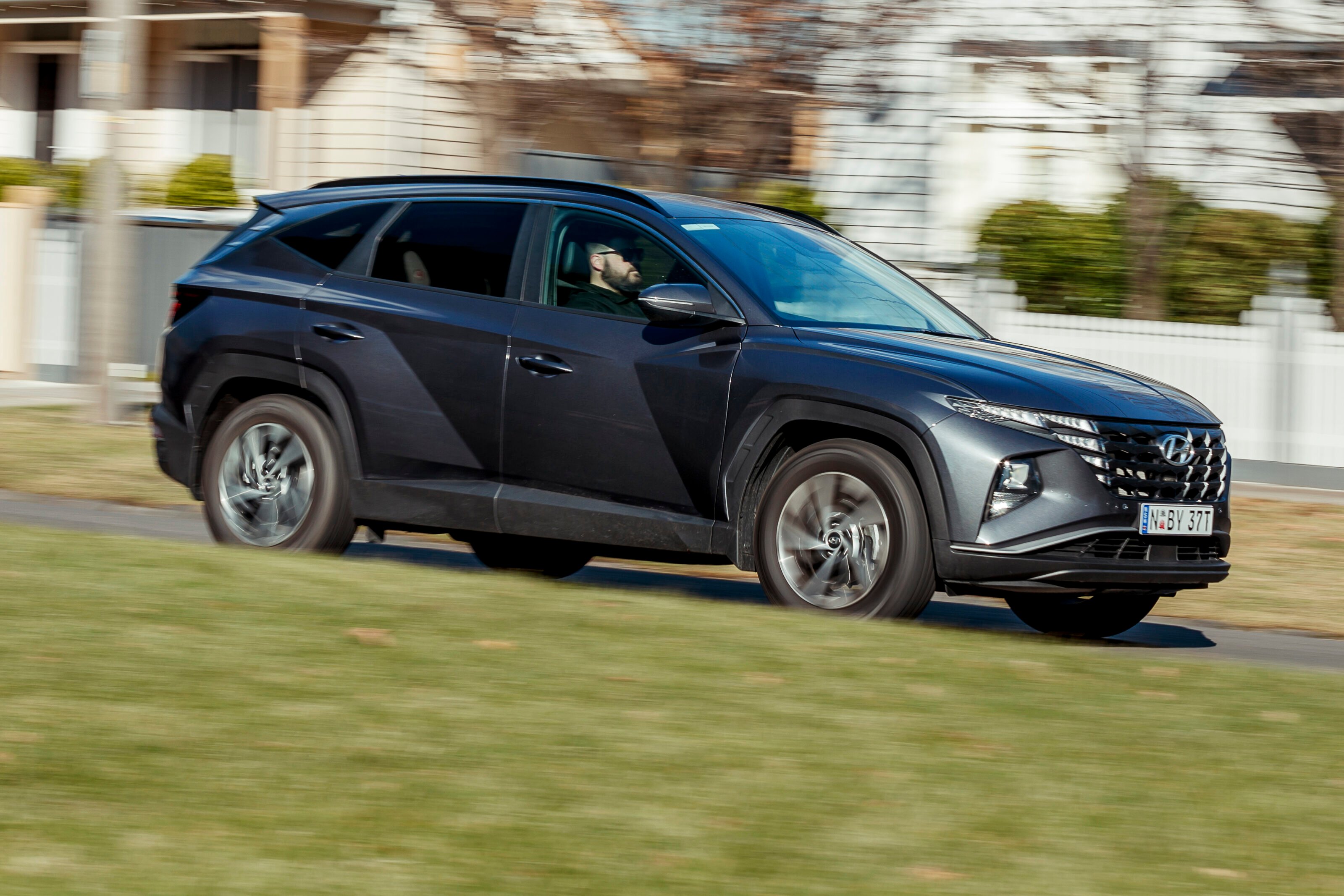
You can deactivate the system, but I won’t say thankfully. While I’m confident in my attention to responsible driving, I’d prefer to see inattentive drivers (and anybody around them) benefiting from the alerts and active protection that lane-keeping technology offers.
On one occasion, while safely navigating an outdoor car park on a sunny morning, two pedestrians walking past the path of the vehicle on a separated path with a fence in between us, were detected as potential obstacles as I rounded a corner – in that brief moment that the car was pointing at the couple – and the Tucson’s autonomous braking system threw out the anchors and brought us to a sudden stop. My partner looked at me accusingly, for having braked so unexpectedly – “it wasn’t me!” I cried. You’d think the AEB beeping would be evidence enough, but alas.
These two moments are representative of numerous frustrating experiences with the Tucson’s active safety systems, and it’s only a shame we didn’t have the car covered in cameras. A project for the future, perhaps.
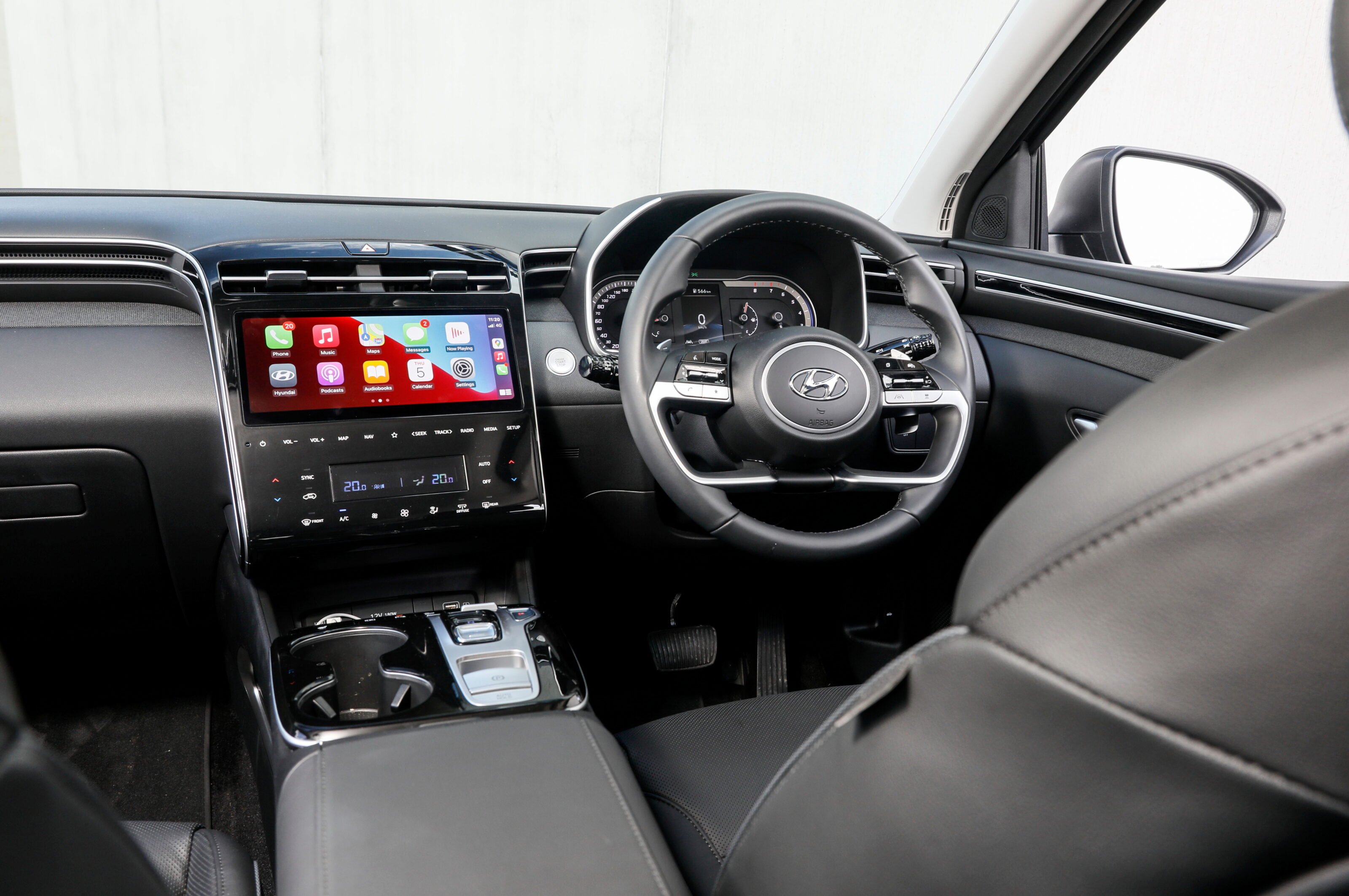
Those quirks aside, this last instalment sees me swapping out of the underwhelming petrol, front-wheel-drive Tucson Elite into one that better lives up to the name: a 2.0-litre turbo-diesel, all-wheel-drive Tucson Elite. (This one’s ‘Shimmering Silver’, but otherwise identical to the petrol car you see here.)
The diesel offers 137kw and 416Nm – up from the 115kW and 192Nm. Power may only be up a smidge, but with more than double the torque offered with the petrol model, the difference behind the wheel is night-and-day.
Add to that the surety of all-wheel drive and an eight-speed automatic in place of the six-speed offered with the lowly petrol, and the $6000 premium feels well justified.
While it’s not one of the dual-clutch options Hyundai offers in a number of other models, the conventional eight-speed torque converter is a smooth, intelligent unit. Where the six-speed of the willing but underweight petrol engine would desperately hold onto gears, the eight-speed plays more confidently with its extra ratios and torque.
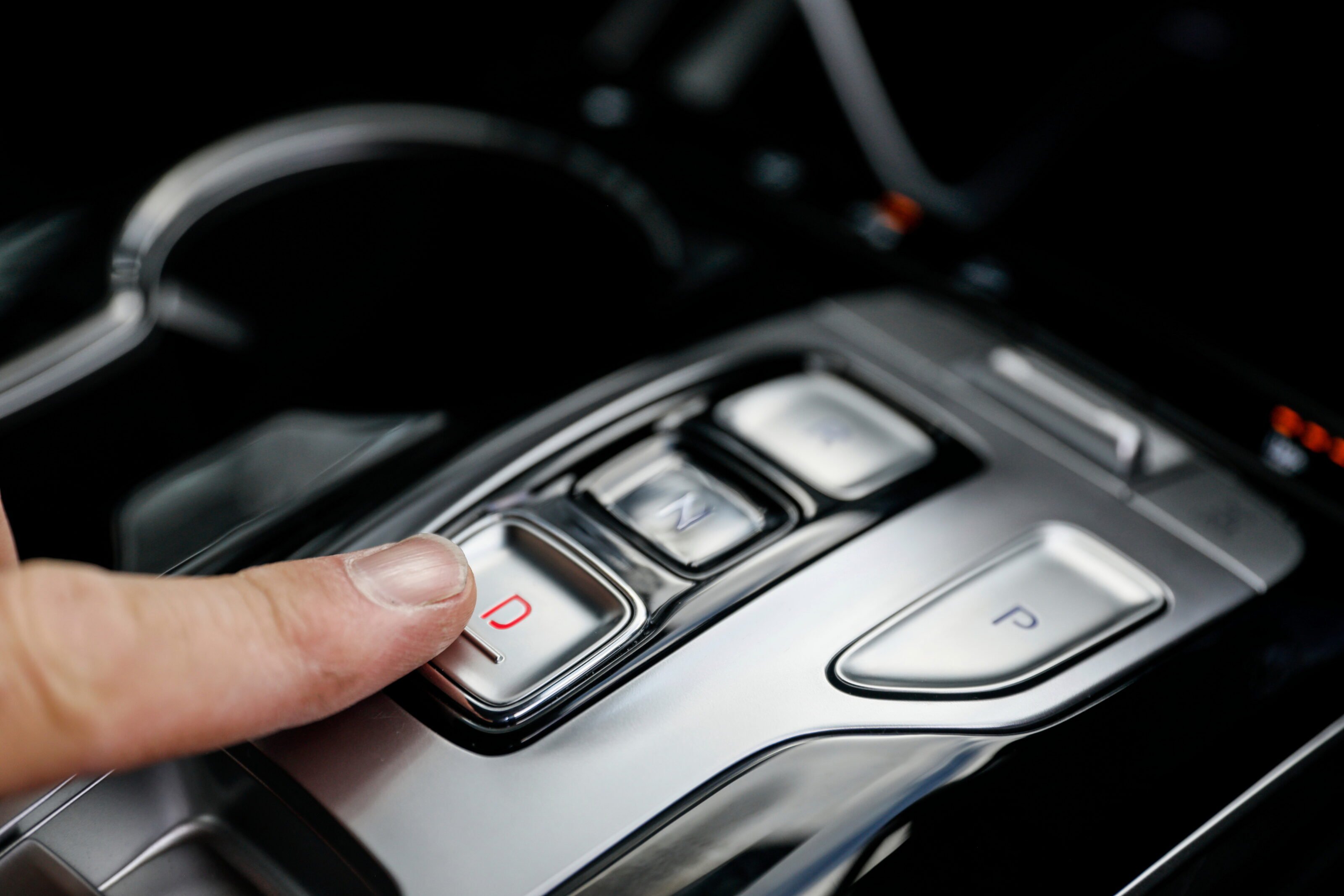
Ride comfort in the diesel, like with the petrol model, is firm but not jarring – endowing the Tucson with a more sporting feel. The new Tucson misses out on the local tune that was once a staple of Australian-delivered Hyundai models, but it doesn’t suffer for the decision.
Potholes and bumps are dismissed without much fuss on urban roads, while body roll is well controlled for an offering in this segment, the midsize SUV feeling neatly compliant through corners. Steering likewise feels well weighted, lending more confidence in corners and on the highway.
Cabin insulation is good, with most road and wind noise blocked, although the typical diesel noise is ever present – but not to the point of being a bother. I quite like the sound, anyway.
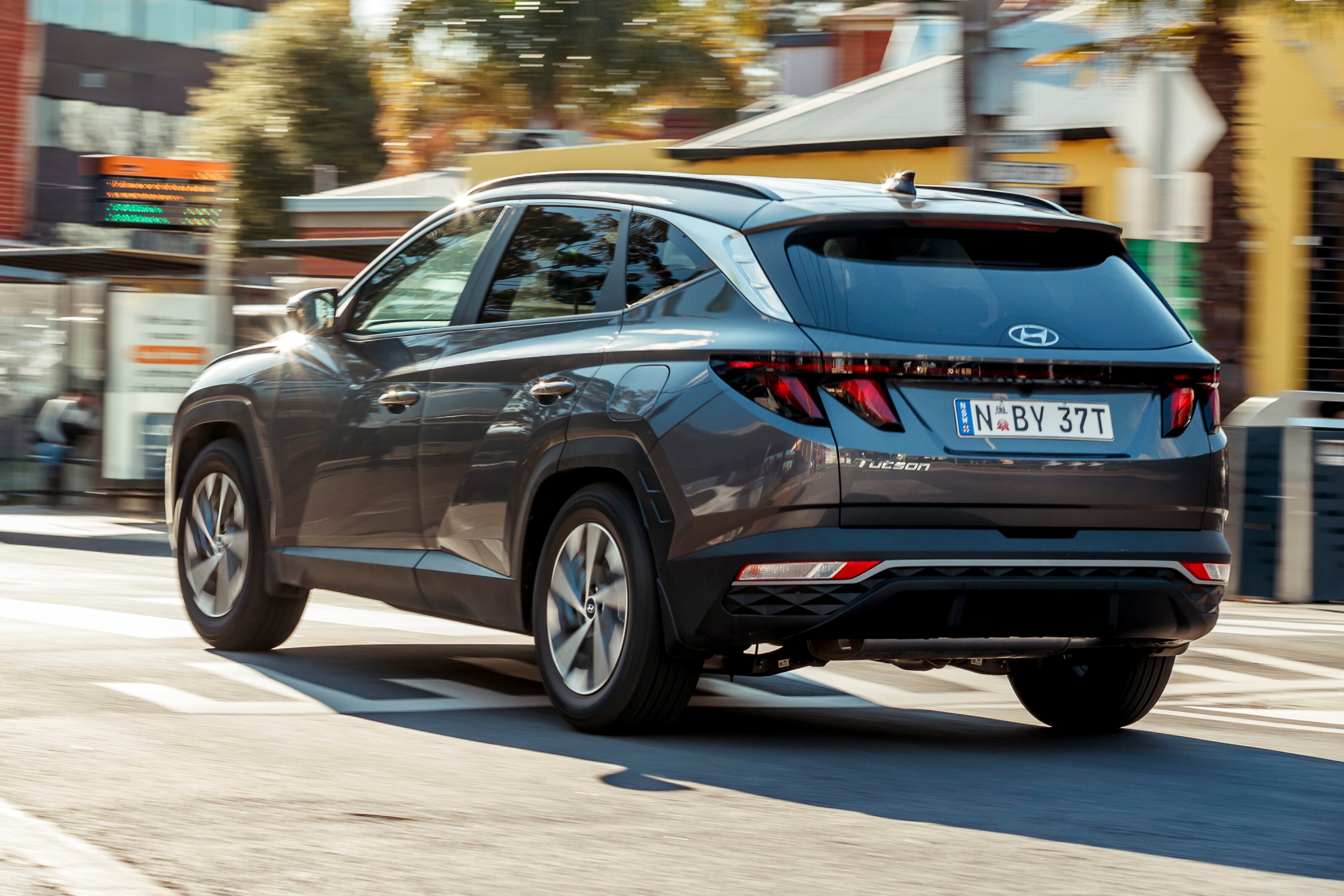
In the leap to a diesel model, fuel consumption has averaged 8.6L/100km in our daily driving, which in lockdown has been made up mostly of runs to the shops with the occasional longer drive for vehicle assessment. Hyundai claims a combined urban/highway figure of 6.3L/100km and an urban figure of 7.7L/100km, so this diesel Tucson is sitting notably above the claimed numbers – but even in this era of supposedly more accurate WLTP certification, higher real-world numbers are common. As always, ‘your mileage may vary’, and we do live in a particularly hilly part of Melbourne.
In all, the new Tucson is an offering I recommend in this diesel form. The 2.0-litre petrol model is just barely worth considering if you’re on a budget, but the $6000 leap to a diesel is worth the spend. There’s also a 1.6 turbo petrol option for $2000 less than the diesel, and it would be worth a spin before deciding.
Things we like about the diesel Tucson:
- Build quality, good interior space and comfort
- Simple, modern infotainment
- The holy trinity of a torquey diesel, smart auto and all-wheel drive
- Invasive lane-keep assistant
- No particularly clever storage tricks
- Fuel consumption a little high on test
Things we like
- Details-oriented design themes
- Competitive standard-fit safety features
- Spacious cabin
Not so much
- 2.0 litre non-turbo petrol engine doesn't inspire confidence
- Lane-keep system overly aggressive
We recommend
-
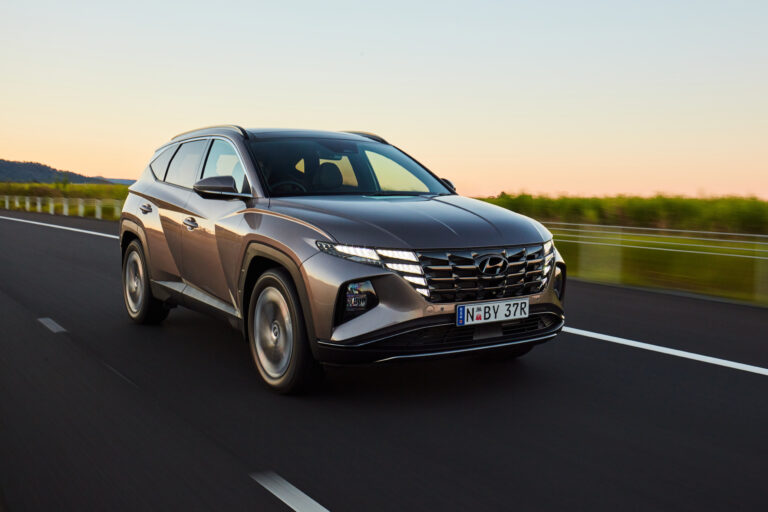 News
News2021 Hyundai Tucson pricing and features
Mid-size SUV scores more tech, safety, three powertrains and a simplified range
-
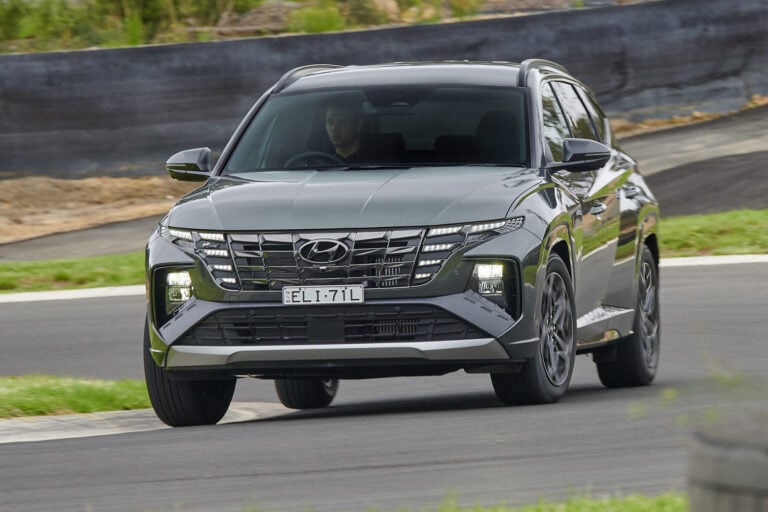 Reviews
ReviewsFirst drive: 2021 Hyundai Tucson N Line 1.6 petrol review
N-light Hyundai Tucson N Line arrives in N-ticipation of more sporty machinery
-
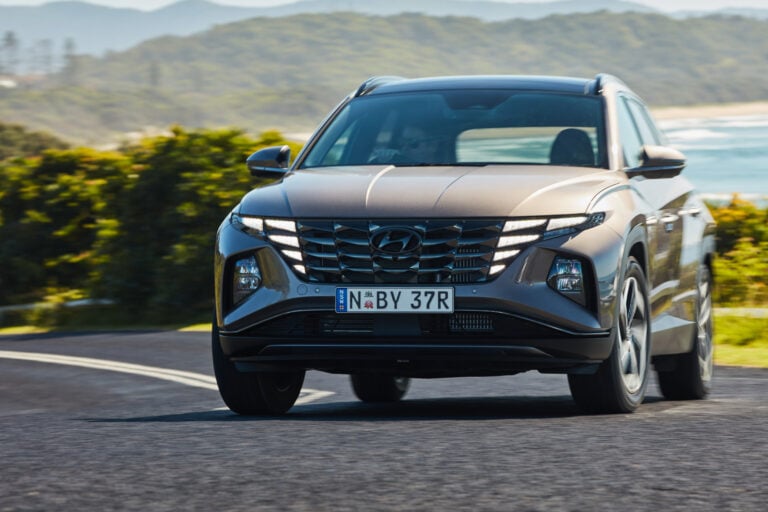 Reviews
Reviews2021 Hyundai Tucson Highlander FWD review
The 2.0-litre petrol powertrain is the most affordable way into the luxurious Highlander spec of Hyundai's all-new Tucson


